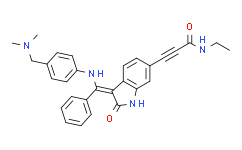BI 847325 inhibits the activity of X. laevis AK-B with an IC50 of 3 nM; the IC50 values for human AK-A and AK-C are 25 and 15 nM, respectively. BI 847325 also inhibits human MEK1 and MEK2 with respective IC50 values of 25 and 4 nM. BI 847325 at 1,000 nM inhibits 6 enzymes by more than 50% (LCK, MAP3K8, FGFR1, AMPK, CAMK1D and TBK1) and the IC50 values are below 100 nM only for LCK (5 nM) and MAP3K8 (93 nM). Proliferation is inhibited in A375 and Calu-6 cell lines with GI50 values of 7.5 nM and 60 nM, respectively.
Medlife has not independently confirmed the accuracy of these methods. They are for reference only.



 扫码关注公众号
扫码关注公众号